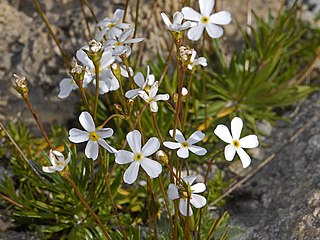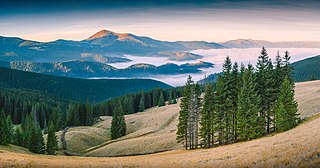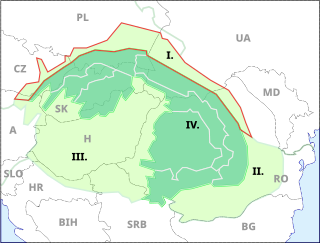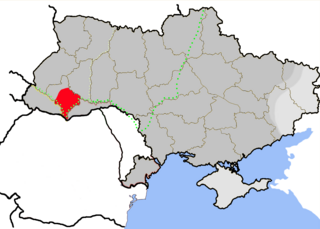 W
WThe Carpathian Mountains or Carpathians are a range of mountains forming an arc throughout Central and Eastern Europe. Roughly 1,500 km (932 mi) long, it is the third-longest European mountain range after the Urals at 2,500 km (1,553 mi) and the Scandinavian Mountains at 1,700 km (1,056 mi). The range stretches from the far eastern Czech Republic (3%) in the northwest through Slovakia (17%), Poland (10%), Hungary (4%) and Ukraine (10%) Serbia (5%) and Romania (50%) in the southeast. The highest range within the Carpathians is known as the Tatra mountains in Slovakia and Poland, where the highest peaks exceed 2,600 m (8,530 ft). The second-highest range is the Southern Carpathians in Romania, where the highest peaks range between 2,500 m (8,202 ft) and 2,550 m (8,366 ft).
 W
WDivisions of the Carpathians are a categorization of the Carpathian mountains system.
 W
WAbies alba, the European silver fir or silver fir, is a fir native to the mountains of Europe, from the Pyrenees north to Normandy, east to the Alps and the Carpathians, Slovenia, Croatia, Bosnia and Herzegovina, Montenegro, Serbia, and south to Italy, Bulgaria, Albania and northern Greece; it is also commonly grown on Christmas tree plantations in the North East region of North America spanning New England in the US to the Maritime provinces of Canada.
 W
WAndrosace lactea, the milkwhite rock jasmine, is an alpine plant, in the family Primulaceae.
 W
WGentiana frigida is a small flowering plant of the genus Gentiana, native to the Carpathian Mountains and eastern Alps.
 W
WBoykos, or simply Highlanders, are a Ukrainian ethnographic group located in the Carpathian Mountains of Ukraine, Slovakia, Hungary, and Poland. Along with the neighboring Lemkos and Hutsuls, the Boykos are a sub-group of the Rusyns, who are often regarded as a sub-group of Ukrainian people and speak a variety of Rusyn language, the Boyko's dialect of the South-Western dialect of the Ukrainian language. Boykos differ from their neighbors in dialect, dress, folk architecture, and customs.
 W
WCarpathian Biosphere Reserve is a biosphere reserve that was established as a nature reserve in 1968 and became part of the World Network of Biosphere Reserves of UNESCO in 1992. Since 2007 bigger portion of the reserve along with some territories of the Uzh River National Park was listed with the UNESCO World Heritage Sites as part of the Ancient and Primeval Beech Forests of the Carpathians and Other Regions of Europe.
 W
WThe Carpathian montane conifer forests, also known as Carpathian montane forests, is a temperate coniferous forests ecoregion in the Carpathian Mountains of the Czech Republic, Poland, Slovakia, Ukraine, and Romania.
 W
WFolk costumes from Podhale region - costumes wear by Highlanders (Gorals) in Polish area of the Tatra Mountains, Podhale region. Unlike other regional groups in Poland, Highlanders from Podhale wear traditional outfit on a daily basis. This type of outfit is widely considered one of the Polish national costumes.
 W
WGalicia was a historical and geographic region at the crossroad of Central and Eastern Europe. It was once the small Kingdom of Galicia–Volhynia and later a crown land of Austria-Hungary, the Kingdom of Galicia and Lodomeria, which straddled the modern-day border between Poland and Ukraine. The area, named after the medieval city of Halych, was first mentioned in Hungarian historical chronicles in the year 1206 as Galiciæ. In 1253 Prince Daniel of Galicia was crowned the King of Rus or King of Ruthenia following the Mongol invasion in Ruthenia. In 1352 the Kingdom of Poland annexed the Kingdom of Galicia and Volhynia as the Ruthenian Voivodeship.
 W
WThe Kingdom of Galicia and Lodomeria, also known simply as Galicia or Austrian Poland, was established in 1772 as a crownland of the Habsburg Monarchy as a result of the First Partition of Poland. After the Third Partition of Poland in 1795, it became a kingdom under Habsburg rule. In 1804 it became a crownland of the Austrian Empire. From 1867 it was a Polish-administered autonomous crownland under Cisleithanian Austria-Hungary, until its dissolution in 1918. The country was carved from the entire south-western part of the Polish–Lithuanian Commonwealth. Among the many ceremonial titles of the princes of Hungary was "ruler of Galicia and Lodomeria". Following the Napoleonic Wars and the Congress of Vienna, the Austrian Empire ceded portions of Galicia to the Russian Empire, West Galicia and Tarnopol District.
 W
WThe Transylvanian Plain is an ethnogeographical area in Transylvania, Romania, located between the Someș River and the Mureș River. It is populated by both ethnic Romanians and ethnic Hungarians.
 W
WOuter Subcarpathia denotes the depression area at the outer base of the Carpathian arc, including foothills of the Outer Western Carpathians and Outer Eastern Carpathians. It stretches from northeastern Austria, through eastern Czech Republic, southern Poland, western Ukraine and northeastern Romania.
 W
WPokuttya or Pokuttia is an historical area of East-Central Europe, situated between the Dniester and Cheremosh rivers and Carpathian Mountains, in southwestern part of modern Ukraine. Historically it was a culturally distinct area inhabited by Ukrainians and Romanians on the previously unpopulated borders between Lviv and Halych. Although the historical centre of the area was Kolomyia, the name itself is derived from the town of Kuty that literally means 'round the corner'. The region is now inhabited mainly by Ukrainians.
 W
WPrykarpattia is a Ukrainian term for Ciscarpathia, a physical geographical region for the northeastern Cartpathian foothills.
 W
WThe shepherd's axe is a long thin light axe of Eurasian origin used in past centuries by shepherds in the Carpathian Mountains and in other territories which comprise today Slovakia, Czech Republic, Poland, Ukraine, Romania and Hungary. The features of a shepherd's axe combine a tool with a walking stick, that could be used as a light weapon. It has symbolic historical and cultural connotations and is still used as a prop in many traditional dances, for example the odzemok.
 W
WThe vernacular architecture of the Carpathians draws on environmental and cultural sources to create unique designs.